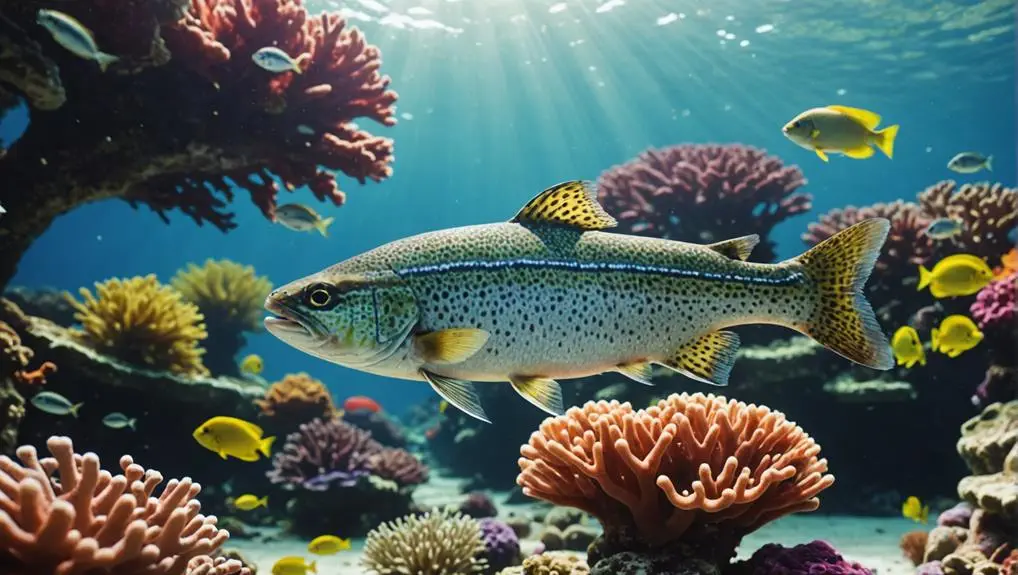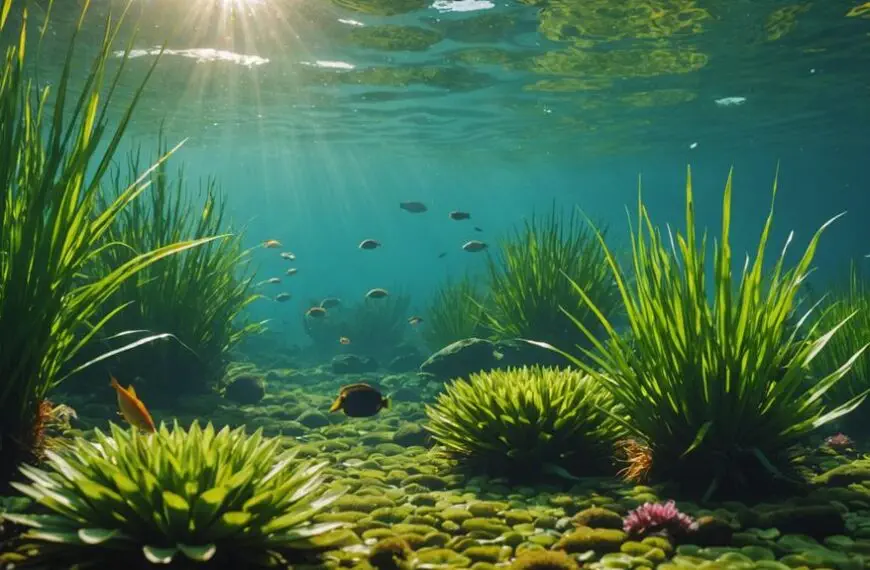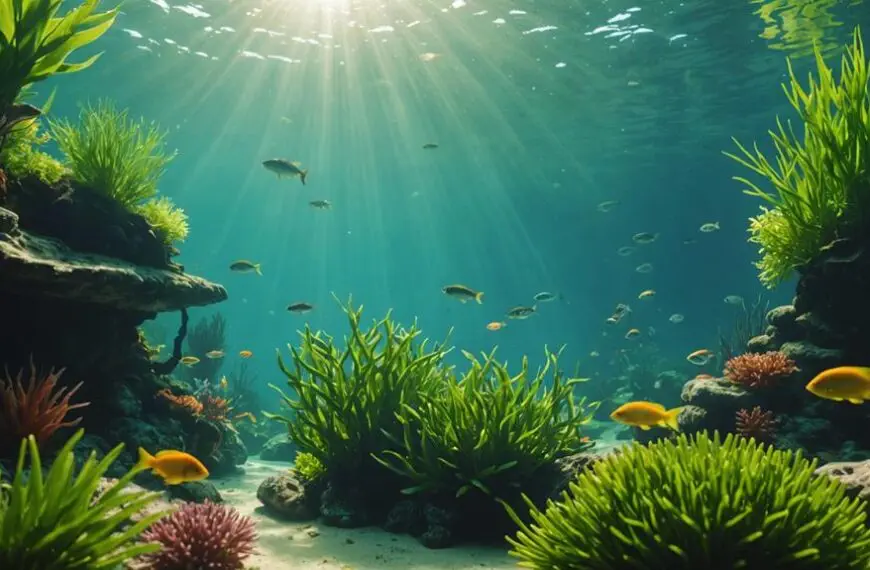If you're looking for sustainable fish species to keep on your plate, you've got some tasty choices! Try anchovies, known for their high omega-3 content and low mercury levels. There's also Arctic Char, which has a mild flavor and comes from eco-friendly farms. Don't forget about bivalves like clams and mussels, which help filter the ocean while being low-impact. Skipjack tuna and Dungeness crab are great options too, caught responsibly. Plus, silver hake is a sustainable cod alternative! It's a win-win for your taste buds and the planet. Curious about more options? Stick around for some tasty details!
Contents
- 1 Anchovies: A Sustainable Choice
- 2 Arctic Char: Eco-Friendly Farming
- 3 Bivalves: Clams, Mussels, and More
- 4 Hake: Mild Flavor, Sustainable Source
- 5 Prawns and Shrimp: Responsible Farming
- 6 Albacore Tuna: Low Mercury Options
- 7 Dungeness Crab: Trap-Caught Sustainability
- 8 Silver Hake: A Cod Alternative
- 9 Alaskan Salmon: Wild-Caught Quality
- 10 Skipjack Tuna: A Smart Seafood Pick
- 11 Frequently Asked Questions
- 12 Final Thoughts
Anchovies: A Sustainable Choice
Choosing anchovies as a sustainable seafood option offers numerous benefits for both your health and the environment. You might be surprised to learn that anchovies are typically wild-caught in the nutrient-rich waters of Peru and Chile, where the fish thrive thanks to healthy stock levels.
Their rapid reproduction rates make them a resilient species, which is a huge plus for sustainable fishing practices.
When you pick anchovies, you're not just treating your taste buds; you're also making a smart choice for your heart. These little powerhouses are packed with omega-3 fatty acids, which are great for your overall well-being.
Plus, they're low in mercury compared to larger fish, so you can enjoy them without the worry.
Look for the MSC label when you buy anchovies; it's a reliable sign that they come from well-managed fisheries. By choosing anchovies, you're supporting sustainable fishing practices and helping to protect our oceans.
Arctic Char: Eco-Friendly Farming
Often regarded as a sustainable seafood option, Arctic char is primarily farmed in eco-friendly aquaculture systems that prioritize clean water sources. This thoughtful approach minimizes environmental impact compared to traditional fish farming methods, making it a great choice for your next meal.
When you choose Arctic char, you're supporting practices that promote sustainability. Here are three key benefits of eco-friendly farming for this delicious fish:
- Water Conservation: Recirculating aquaculture systems (RAS) dramatically reduce water usage, helping to keep our planet's resources intact.
- Rapid Growth: Arctic char grows quickly, typically ready for harvest in just 18 months. This efficiency supports a sustainable fish farming cycle.
- Fewer Contaminants: Opting for certified sustainable farms ensures lower levels of harmful substances compared to some wild-caught fish.
With a taste and texture similar to salmon, Arctic char can be prepared in various ways, delighting your family and friends.
Bivalves: Clams, Mussels, and More

When you think of sustainable seafood, bivalves like clams, mussels, and oysters should definitely come to mind.
These little gems not only require minimal feed but also help clean our oceans while they're at it—talk about multitasking!
Plus, with their eco-friendly farming methods, you can enjoy a delicious meal without feeling guilty about your impact on the planet.
Nutrient Efficiency Benefits
Bivalves, such as clams and mussels, offer impressive nutrient efficiency benefits that make them standout choices in sustainable seafood.
These delightful creatures not only taste great but also play a significant role in enhancing our environment.
Here are three key reasons to consider bivalves:
- Minimal Feed Input: Bivalves are nutrient-efficient; they require little to no additional feed, unlike many fish species. They naturally filter nutrients from the water, creating a win-win for you and the ocean.
- High Nutritional Value: Packed with essential nutrients like omega-3 fatty acids, vitamin B12, iron, and zinc, bivalves contribute to a healthy diet. Your guests will love the flavor and the health benefits!
- Environmental Impact: Farming bivalves generates lower greenhouse gas emissions, aligning with sustainable practices. They improve water quality by filtering out pollutants, which helps support biodiversity in marine ecosystems.
Sustainable Farming Practices
In the realm of sustainable seafood, clams, mussels, and oysters shine as prime examples of eco-friendly farming practices. These bivalves aren't just delicious; they're nutrient-efficient and require minimal feed, which helps keep their aquatic homes healthy.
Imagine a world where your seafood choices improve water quality—well, that's what bivalve farming does! By suspending these little treasures in water, they naturally filter and clean their environment.
What's even better? Bivalve aquaculture practices generate low carbon emissions compared to traditional fish farming. So, while you're enjoying that tasty plate of mussels, you're also doing Mother Earth a favor.
Plus, bivalves reproduce quickly, making them fantastic candidates for sustainable harvesting techniques when managed responsibly.
And if you want to support local economies, look for community-supported fisheries (CSFs) that promote bivalve aquaculture. You'll find fresh options while encouraging sustainable fishing practices.
Hake: Mild Flavor, Sustainable Source
Hake offers a mild flavor and lean texture, making it a versatile choice for various dishes like soups and casseroles. If you're looking to impress your family or friends, hake is a fantastic option. Not only does it taste great, but it's also a sustainable source of seafood, which is something we can all feel good about.
Here are a few reasons to consider hake for your next meal:
- Sustainable Fishing Methods: Many fisheries have embraced responsible practices that help keep hake populations healthy.
- Abundant Supply: You'll often find hake sourced from well-managed fisheries in European waters.
- Delicious Cooking Techniques: Whether you bake, grill, or fry it, hake's delicate texture holds up beautifully while enhancing its natural flavor.
When you're shopping for hake, keep an eye out for certified sustainable varieties. This ensures you're making a choice that minimizes environmental impact.
Prawns and Shrimp: Responsible Farming
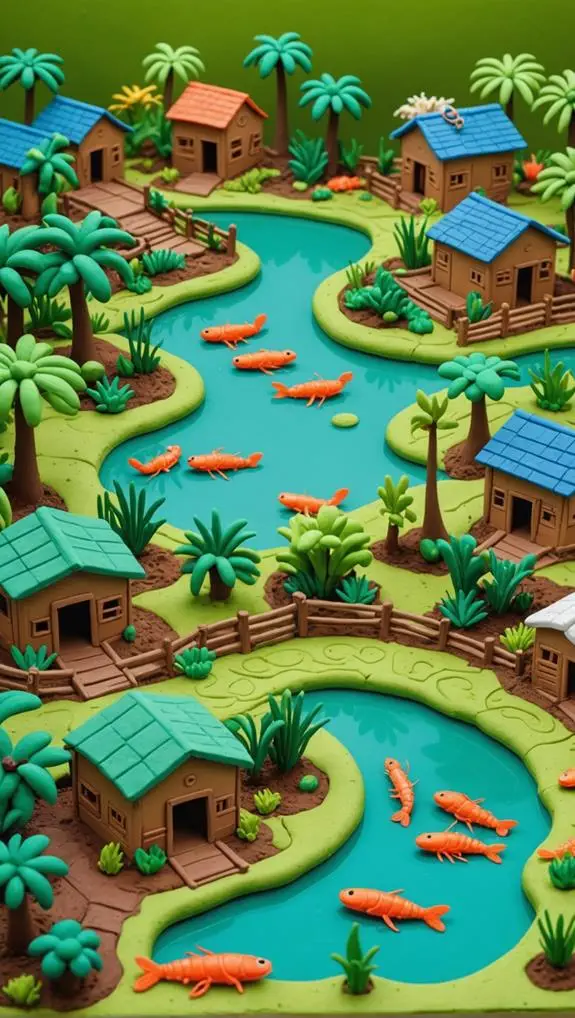
When it comes to enjoying prawns and shrimp, knowing how they're farmed makes a world of difference.
You'll be pleased to learn that many farms follow sustainable practices, using certifications like the Aquaculture Stewardship Council to help you pick the best options.
Sustainable Farming Practices
Sustainable farming practices for prawns and shrimp are crucial for minimizing environmental impact while ensuring a steady supply of seafood.
By adopting responsible farming methods, you can enjoy delicious, sustainable seafood without harming our planet. Here are three key practices to consider:
1. Recirculating Aquaculture Systems (RAS): These systems recycle water, cutting down on usage and reducing pollution.
It's like giving the environment a refreshing spa day!
2. Polyculture Techniques: By co-cultivating multiple species, you create a balanced ecosystem that helps improve habitat health.
Who knew that farming could be like hosting a diverse party?
3. Integrated Pest Management (IPM): This approach reduces the need for chemicals while keeping shrimp healthy and ecosystems intact.
Think of it as the natural way to keep your shrimp in tip-top shape!
Certification Importance
Choosing prawns and shrimp that come with trusted certifications can make a significant difference in promoting responsible farming practices. When you pick certified sustainable seafood, you're not just treating yourself to a delicious meal; you're supporting better fishery management and healthier marine species. Certifications like the Aquaculture Stewardship Council (ASC) and Best Aquaculture Practices (BAP) ensure that these tasty treats are raised in ways that respect our environment and communities.
Sustainable shrimp farming is all about maintaining water quality, cutting down on waste, and protecting vital habitats like mangroves. These practices are crucial for keeping biodiversity intact. By choosing shrimp products with eco-labels, you're doing your part to encourage farms to embrace responsible methods. It's like giving a high-five to those farmers who care about our planet!
Every time you buy certified sustainable shrimp, you're directly supporting efforts to reduce harmful fishing practices. So next time you're at the store, look for those labels. You'll not only make a tasty choice but also join a movement that's making a real difference in the world of seafood. Your choices matter, and they can help create a brighter future for our oceans!
Albacore Tuna: Low Mercury Options
Albacore tuna stands out as a smart choice for those looking to enjoy seafood without the worry of high mercury levels. This delicious fish not only boasts a mild flavor and firm texture but also offers low mercury options when sourced correctly.
If you're eager to serve something nutritious and sustainable, consider these points:
- Choose Troll or Pole Caught: Albacore tuna caught through troll or pole methods in U.S. and Canadian Pacific waters are recognized for lower mercury levels.
- Check for Certifications: Look for certified sources that prioritize sustainable fishing practices—this helps protect our oceans and keeps marine ecosystems healthy.
- Nutritional Benefits: Albacore tuna is packed with omega-3 fatty acids, essential for heart health, making it a fantastic addition to any meal.
Dungeness Crab: Trap-Caught Sustainability
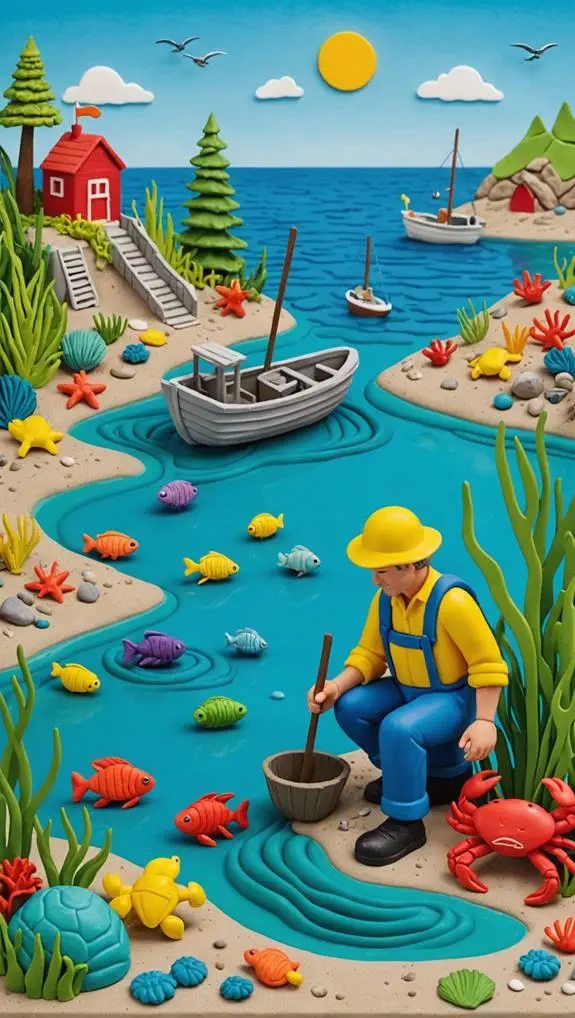
When it comes to enjoying delicious seafood, Dungeness crab offers a perfect blend of flavor and sustainability. Imagine cracking open a sweet, juicy crab with snow-white meat that's sure to impress your guests.
But here's the best part: when you choose trap-caught Dungeness crab, you're supporting sustainable management practices that protect our oceans.
These crabs are primarily harvested along the West Coast of the United States, where fisheries use traps to minimize bycatch. This means fewer unintended catches of other marine life, keeping our ecosystems healthy.
Plus, sustainable harvesting is monitored through scientific assessments, ensuring we don't overfish this tasty treasure.
When you're shopping for Dungeness crab, look for the Marine Stewardship Council (MSC) label. This certification shows that the crab was caught responsibly and helps protect the environment.
You can feel great about serving it at your next gathering, knowing you're making a smart choice for both your taste buds and the planet.
Silver Hake: A Cod Alternative
Silver hake is an excellent choice if you're looking for a sustainable alternative to cod. This fish isn't just delicious; it's also a smart pick for the environment! With its mildly sweet flavor, silver hake is gaining popularity and can be a great addition to your meals.
Here are three reasons to consider it:
- Sustainable Practices: Silver hake is mainly harvested from the Atlantic Ocean, and thanks to effective fisheries management, most stocks are recovering beautifully.
- Environmentally Friendly: Fishery operations use methods that minimize bycatch, which helps maintain healthy ecosystems. You can feel good about your choice!
- Culinary Versatility: Whether you bake, sauté, or grill it, silver hake retains moisture well and works with various recipes.
When you choose silver hake, look for MSC-certified options to support responsible fishing practices. By doing so, you're not just filling your plate with a tasty dish; you're also contributing to the sustainability of marine resources.
Alaskan Salmon: Wild-Caught Quality
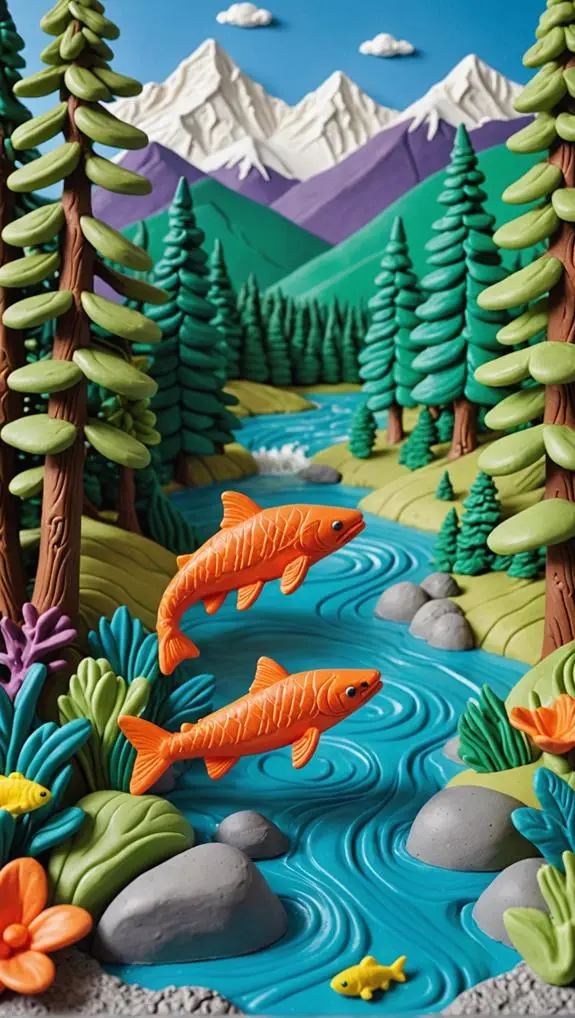
If you're after a seafood option that stands out for its quality and flavor, look no further than wild-caught Alaskan salmon. This fish, especially varieties like sockeye and king salmon, is beloved by seafood lovers for its rich taste and texture.
You'll be pleased to know that Alaskan salmon isn't just delicious; it's also a healthy choice packed with omega-3 fatty acids, which are great for heart health.
When you choose Alaskan salmon, you're supporting a fishery that's sustainably managed. Strict regulations help keep salmon populations healthy and thriving, ensuring there'll be plenty for future generations to enjoy.
Plus, fishing methods like gillnetting and trolling are designed to minimize bycatch, protecting our precious marine ecosystems—talk about a win-win!
If you want to feel good about your seafood choices, look for Alaskan salmon with the Marine Stewardship Council (MSC) certification. It's an easy way to know you're getting fish that's been caught responsibly.
Skipjack Tuna: A Smart Seafood Pick
When you think of a smart seafood choice, skipjack tuna should definitely come to mind!
Not only is it packed with nutritional benefits, but it's also sourced sustainably, making it a win-win for your plate and the planet.
Plus, whether you're whipping up sushi or tossing it in a salad, cooking with skipjack tuna is as easy as pie—well, maybe easier!
Nutritional Benefits of Skipjack
Skipjack tuna stands out as a smart seafood choice, delivering a remarkable 24 grams of protein in just a 3-ounce serving. This makes it an excellent pick for those wanting to maintain muscle and overall health.
Plus, it's low in calories—around 100 per serving—so you can enjoy it guilt-free!
Here are some nutritional benefits of skipjack tuna that you'll love:
- Omega-3 Fatty Acids: These heart-healthy fats can help reduce inflammation and keep your heart ticking strong.
- Vitamins and Minerals: It's packed with vitamin B12 for nerve function and selenium, an antioxidant that boosts immune health.
- Lower Mercury Levels: Compared to larger tuna species, skipjack has lower mercury levels, making it a safer choice for everyone, especially pregnant women.
Sustainable Sourcing Practices
Choosing skipjack tuna isn't just about nutritional benefits; it's also a smart move for sustainability. When you opt for skipjack tuna, you're supporting sustainable sourcing practices that help maintain our oceans' health. This fish is often caught using pole-and-line or handline methods. These techniques minimize bycatch and keep the environmental impact low.
Plus, many fisheries are certified by the Marine Stewardship Council (MSC), ensuring responsible management of skipjack tuna populations.
Not only is skipjack tuna a more sustainable choice, but it also tends to have lower mercury levels than larger tuna species like albacore or bluefin. This means you can enjoy it without worrying too much about heavy metal exposure.
Cooking Methods and Tips
A delicious and versatile option, skipjack tuna shines in various cooking methods, making it a favorite among seafood lovers.
This fish species not only offers rich flavor but is also a more sustainable choice, especially when sourced from well-managed fisheries.
Here are three fantastic cooking methods you can try:
- Grilling: Marinate your skipjack tuna in citrus or soy-based sauces for about 30 minutes. Grill it for just 1-2 minutes on each side for that perfect medium-rare doneness. Trust me, the flavor will burst in your mouth!
- Searing: If you're short on time, searing is quick and easy. Just heat a pan, add a little oil, and sear the tuna for a couple of minutes. This method locks in moisture and enhances its natural richness.
- Sushi or Salads: Skipjack tuna is fantastic raw! Use it in sushi rolls or salads for a fresh and healthy dish that'll impress your guests.
Frequently Asked Questions
What Is the Most Sustainable Fish?
When considering the most sustainable fish, you should look for options that promote sustainable fishing practices, protect fish habitats, and minimize environmental impact. Choices like wild-caught Alaskan salmon and Pacific cod are excellent examples of sustainability.
What Is Maximum Sustainable Fish?
When it comes to maximum sustainability criteria, you'll want to consider ecological impact assessments. Understanding fish population dynamics helps you ensure that your fishing practices support healthy ecosystems while serving the needs of future generations.
What Fish Is Not Sustainable?
You should avoid fish like Atlantic Cod and Bluefin Tuna, as overfishing impacts their populations. Supporting ethical fishing practices helps protect endangered species and promotes sustainable fisheries, ensuring healthier oceans for future generations.
Which Fish Can Not Be Farmed?
Imagine trying to farm bluefin tuna; you can't. Their migratory nature and role in ocean ecosystems make wild caught essential. Supporting fish conservation means understanding which species, like tuna, simply can't thrive in captivity.
Final Thoughts
Choosing sustainable fish is like picking the freshest fruit at the market—it makes a difference. By opting for species like anchovies and Arctic char, you're not just treating your taste buds but also protecting our oceans. It's all about making smart choices that benefit both you and the planet. So, the next time you're at the seafood counter, remember to look for those eco-friendly options. Your plate can be delicious and responsible, just like a well-balanced meal!

